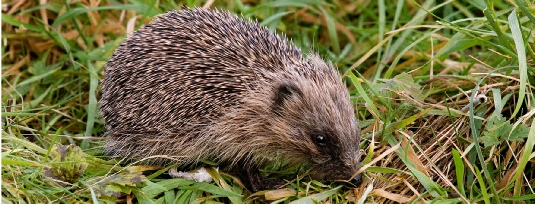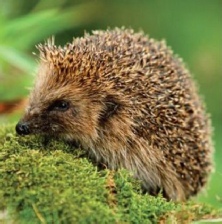



Hedgehog Conservation: Factors causing loss or decline
- Environmental changes are likely to be the cause of the drop in Hedgehog numbers with the loss of and fragmentation of habitat.
- More intensive agriculture – with larger fields and the loss of hedgerows and permanent grassland – has played a major role.
- Gardens, parks and school grounds have become too tidy and smaller, paved over for parking, or enclosed with impenetrable fences and walls.
- New buildings and roads carve up suitable habitat, so that small populations can become isolated and more vulnerable. Road deaths might also be a cause of decline in busy areas.
- The use of pesticides reduces the amount of prey available. Slug pellets and weedkillers can harm hedgehogs directly.
- Changes in weather can disrupt hibernation, the availability of food and the chances of young surviving the winter.
Conservation of hedgehogs
Hedgehogs are often found in suburban areas, and gardens, grounds and parks can be made better for supporting hedgehogs:
- Make sure Hedgehogs can get in and out: have hedges as boundaries or leave small openings at the base of fences and walls
- Provide shelter for Hedgehogs and conditions for their invertebrate diet: piles of logs, twigs or leaves, compost heaps; shrubs and areas of undergrowth, grassy areas with a variety of heights of grass
- Provide water: small ponds or topped-up drinking bowls
- Avoid using chemicals including slug pellets, weedkillers etc
- Remove items that can trap or ensnare Hedgehogs; check bonfires before lighting; check long grass before strimming etc
- Hedgehog boxes can act as shelter for hibernation or nesting
- Supplementary feeding may be useful during periods of periods of drought when natural invertebrate foods may be hard to come by.
The best conservation management of wider habitats is to maintain:
- scrubby areas, dense undergrowth and patches of brambles
- hedgerows and field margins
- grassy areas with grass swards of different heights
- and natural corridors between suitable habitats.
Badgers and Hedgehogs
Badgers are a natural predator of Hedgehogs and Hedgehogs actively avoid sites where there are Badgers in high numbers.
When there is sufficient cover and foraging opportunities, Badgers and Hedgehogs can coexist, but when there is no safe refuge and the prey that the two species compete for is scarce, Hedgehogs may lose out.
Legal protection
Hedgehogs are partially protected under Schedule 6 of the Wildlife and Countryside Act (1981) and may not be killed or trapped without a licence. Updated in the Countryside and Rights of Way Act 2000.
The Wild Mammals Protection Act (1996) prohibits cruel treatment of Hedgehogs and it is generally prohibited to remove Hedgehogs from the wild.
As a Section 41 species under the NERC Act (2006), Hedgehogs need to be taken into consideration by any public body in managing their estate.
For advice and information
British Hedgehog Preservation Society
National Hogwatch survey results
State of British Hedgehogs 2011
Associated Local Priority Habitats
Built Environment -gardens, green spaces …
Parkland
Hedgerow and Field Margins
Acid and Neutral Grasslands
Mixed Deciduous Woodland edges
Open Mosaic on Previously Developed Land

